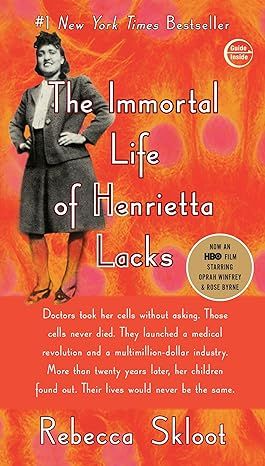The Immortal Life of Henrietta Lacks
4.6
-
28,896 ratings
#1 NEW YORK TIMES BESTSELLER • “The story of modern medicine and bioethics—and, indeed, race relations—is refracted beautifully, and movingly.”—Entertainment Weekly
NOW A MAJOR MOTION PICTURE FROM HBO® STARRING OPRAH WINFREY AND ROSE BYRNE • ONE OF THE “MOST INFLUENTIAL” (CNN), “DEFINING” (LITHUB), AND “BEST” (THE PHILADELPHIA INQUIRER) BOOKS OF THE DECADE • ONE OF ESSENCE’S 50 MOST IMPACTFUL BLACK BOOKS OF THE PAST 50 YEARS • WINNER OF THE CHICAGO TRIBUNE HEARTLAND PRIZE FOR NONFICTION
NAMED ONE OF THE BEST BOOKS OF THE YEAR BY The New York Times Book Review • Entertainment Weekly • O: The Oprah Magazine • NPR • Financial Times • New York • Independent (U.K.) • Times (U.K.) • Publishers Weekly • Library Journal • Kirkus Reviews • Booklist • Globe and Mail
Her name was Henrietta Lacks, but scientists know her as HeLa. She was a poor Southern tobacco farmer who worked the same land as her slave ancestors, yet her cells—taken without her knowledge—became one of the most important tools in medicine: The first “immortal” human cells grown in culture, which are still alive today, though she has been dead for more than sixty years. HeLa cells were vital for developing the polio vaccine; uncovered secrets of cancer, viruses, and the atom bomb’s effects; helped lead to important advances like in vitro fertilization, cloning, and gene mapping; and have been bought and sold by the billions.
Yet Henrietta Lacks remains virtually unknown, buried in an unmarked grave.
Henrietta’s family did not learn of her “immortality” until more than twenty years after her death, when scientists investigating HeLa began using her husband and children in research without informed consent. And though the cells had launched a multimillion-dollar industry that sells human biological materials, her family never saw any of the profits. As Rebecca Skloot so brilliantly shows, the story of the Lacks family—past and present—is inextricably connected to the dark history of experimentation on African Americans, the birth of bioethics, and the legal battles over whether we control the stuff we are made of.
Over the decade it took to uncover this story, Rebecca became enmeshed in the lives of the Lacks family—especially Henrietta’s daughter Deborah. Deborah was consumed with questions: Had scientists cloned her mother? Had they killed her to harvest her cells? And if her mother was so important to medicine, why couldn’t her children afford health insurance?
Intimate in feeling, astonishing in scope, and impossible to put down, The Immortal Life of Henrietta Lacks captures the beauty and drama of scientific discovery, as well as its human consequences.
Kindle
$12.99
Available instantly
Audiobook
$0.00
with membership trial
Hardcover
$16.36
Paperback
$8.44
Ships from
Amazon.com
Payment
Secure transaction
ISBN-10
1400052181
Print length
381 pages
Language
English
Publisher
Crown
Publication date
March 07, 2011
Dimensions
5.22 x 1.08 x 8 inches
Item weight
2.31 pounds
Popular Highlights in this book
Henrietta’s were different: they reproduced an entire generation every twenty-four hours, and they never stopped. They became the first immortal human cells ever grown in a laboratory.
Highlighted by 8,226 Kindle readers
Though no law or code of ethics required doctors to ask permission before taking tissue from a living patient, the law made it very clear that performing an autopsy or removing tissue from the dead without permission was illegal.
Highlighted by 6,963 Kindle readers
Only cells that had been transformed by a virus or a genetic mutation had the potential to become immortal.
Highlighted by 5,881 Kindle readers
What they found was disturbing: in mission after mission, noncancerous cells grew normally in orbit, but HeLa became more powerful, dividing faster with each trip.
Highlighted by 5,286 Kindle readers
Product details
ASIN :
B00338QENI
File size :
6897 KB
Text-to-speech :
Enabled
Screen reader :
Supported
Enhanced typesetting :
Enabled
X-Ray :
Enabled
Word wise :
Enabled
Editorial Reviews
"One of the most graceful and moving nonfiction books I’ve read in a very long time . . . The Immortal Life of Henrietta Lacks . . . floods over you like a narrative dam break, as if someone had managed to distill and purify the more addictive qualities of Erin Brockovich, Midnight in the Garden of Good and Evil and The Andromeda Strain. . . . It feels like the book Ms. Skloot was born to write. It signals the arrival of a raw but quite real talent.”—Dwight Garner, The New York Times
"Skloot's vivid account begins with the life of Henrietta Lacks, who comes fully alive on the page. . . . Immortal Life reads like a novel.”—Eric Roston, The Washington Post
“Gripping . . . by turns heartbreaking, funny and unsettling . . . raises troubling questions about the way Mrs. Lacks and her family were treated by researchers and about whether patients should control or have financial claims on tissue removed from their bodies.”—Denise Grady, The New York Times
“The Immortal Life of Henrietta Lacks is a fascinating read and a ringing success. It is a well-written, carefully-researched, complex saga of medical research, bioethics, and race in America. Above all it is a human story of redemption for a family, torn by loss, and for a writer with a vision that would not let go.”—Douglas Whynott, The Boston Globe
"Riveting . . . raises important questions about medical ethics . . . It's an amazing story. . . . Deeply chilling . . . Whether those uncountable HeLa cells are a miracle or a violation, Skloot tells their fascinating story at last with skill, insight and compassion.”—Colette Bancroft, St. Petersburg Times
“The history of HeLa is a rare and powerful combination of race, class, gender, medicine, bioethics, and intellectual property; far more rare is the writer than can so clearly fuse those disparate threads into a personal story so rich and compelling. Rebecca Skloot has crafted a unique piece of science journalism that is impossible to put down—or to forget.”—Seed magazine
“No one can say exactly where Henrietta Lacks is buried: during the many years Rebecca Skloot spent working on this book, even Lacks’s hometown of Clover, Virginia, disappeared. But that did not stop Skloot in her quest to exhume, and resurrect, the story of her heroine and her family. What this important, invigorating book lays bare is how easily science can do wrong, especially to the poor. The issues evoked here are giant: who owns our bodies, the use and misuse of medical authority, the unhealed wounds of slavery ... and Skloot, with clarity and compassion, helps us take the long view. This is exactly the sort of story that books were made to tell—thorough, detailed, quietly passionate, and full of revelation.”—TED CONOVER, author of Newjack and The Routes of Man
“It’s extremely rare when a reporter’s passion finds its match in a story. Rarer still when the people in that story courageously join that reporter in the search for what we most need to know about ourselves. When this occurs with a moral journalist who is also a true writer, a human being with a heart capable of holding all of life’s damage and joy, the stars have aligned. This is an extraordinary gift of a book, beautiful and devastating—a work of outstanding literary reportage. Read it! It’s the best you will find in many many years.”—ADRIAN NICOLE LEBLANC, author of Random Family
”The Immortal Life of Henrietta Lacks brings to mind the work of Philip K. Dick and Edgar Allan Poe. But this tale is true. Rebecca Skloot explores the racism and greed, the idealism and faith in science that helped to save thousands of lives but nearly destroyed a family. This is an extraordinary book, haunting and beautifully told.”—ERIC SCHLOSSER, author of Fast Food Nation
“Skloot’s book is wonderful -- deeply felt, gracefully written, sharply reported. It is a story about science but, much more, about life.”—SUSAN ORLEAN, author of The Orchid Thief
“This is a science biography like the world has never seen. What if one of the great American women of modern science and medicine--whose contribution underlay historic discoveries in genetics, the treatment and prevention of disease, reproduction, and the unraveling of the human genome--was a self-effacing African-American tobacco farmer from the Deep South? A devoted mother of five who was escorted briskly to the Jim Crow section of Johns Hopkins for her cancer treatments? What if the untold millions of scientists, doctors, and patients enriched and healed by her gift never, to this day, knew her name? What if her contribution was made without her knowledge or permission? Ladies and gentlemen, meet Henrietta Lacks. Chances are, at the level of your DNA, your inoculations, your physical health and microscopic well-being, you’ve already been introduced.”—Melissa Fay Greene, author of Praying for Sheetrock and There Is No Me Without You
“Heartbreaking and powerful, unsettling yet compelling, The Immortal Life of Henrietta Lacks is a richly textured story of the hidden costs of scientific progress. Deftly weaving together history, journalism and biography, Rebecca Skloot?s sensitive account tells of the enduring, deeply personal sacrifice of this African American woman and her family and, at long last, restores a human face to the cell line that propelled 20th century biomedicine. A stunning illustration of how race, gender and disease intersect to produce a unique form of social vulnerability, this is a poignant, necessary and brilliant book.”—Alondra Nelson, Columbia University; editor of Technicolor: Race, Technology and Everyday Life
“Rebecca Skloot has written a marvelous book so original that it defies easy description. She traces the surreal journey that a tiny patch of cells belonging to Henrietta Lacks’s body took to the forefront of science. At the same time, she tells the story of Lacks and her family—wrestling the storms of the late twentieth century in America—with rich detail, wit, and humanity. The more we read, the more we realize that these are not two separate stories, but one tapestry. It’s part The Wire, part The Lives of the Cell, and all fascinating.”—Carl Zimmer, author of Microcosm
“If virtues could be cultured like cells, Rebecca Skloot’s would be a fine place to start¾a rare combination of compassion, courage, wisdom, and intelligence. This book is extraordinary. As a writer and a human being, Skloot stands way, way out there ahead of the pack.”—MARY ROACH, author of Stiff and Bonk
“The Immortal Life of Henrietta Lacks takes the reader on a remarkable journey—compassionate, troubling, funny, smart—and irresistible. Along the way, Rebecca Skloot will change the way you see medical science and lead you to wonder who we should value more—the researcher or the research subject? Ethically fascinating and completely engaging—I couldn’t recommend it more.”—DEBORAH BLUM, author of The Poisoner’s Handbook and The Monkey Wars and the Helen Firstbrook Franklin professor of journalism at the University of Wisconsin-Madison
“This remarkable story of how the cervical cells of the late Henrietta Lacks, a poor black woman, enabled subsequent discoveries from the polio vaccine to in vitro fertilization is extraordinary in itself; the added portrayal of Lacks's full life makes the story come alive with her humanity and the palpable relationship between race, science, and exploitation.—PAULA J. GIDDINGS, author of Ida, A Sword Among Lions; Elizabeth A. Woodson 1922 Professor, Afro-American Studies, Smith College
“Rebecca Skloot’s steadfast commitment to illuminating the life and contribution of Henrietta Lacks, one of the many vulnerable subjects used for scientific advancement, and the subsequent impact on her family is a testament to the power of solid investigative journalism. Her deeply compelling account of one family’s long and troubled relationship with America’s vast medical-industrial complex is sure to become a cherished classic.”—ALLEN M. HORNBLUM, author of Acres of Skin and Sentenced to Science
“Writing with a novelist’s artistry, a biologist’s expertise, and the zeal of an investigative reporter, Skloot tells a truly astonishing story of racism and poverty, science and conscience, spirituality and family driven by a galvanizing inquiry into the sanctity of the body and the very nature of the life force.”—Booklist (starred review)
“Science journalist Skloot makes a remarkable debut with this multilayered story about ‘faith, science, journalism, and grace.’…Recalls Adrian Nicole LeBlanc’s Random Family…A rich, resonant tale of modern science, the wonders it can perform and how easily it can exploit society’s most vulnerable people.”—Publishers Weekly (starred review)
Sample
1 The Exam
On January 29, 1951, David Lacks sat behind the wheel of his old Buick, watching the rain fall. He was parked under a towering oak tree outside Johns Hopkins Hospital with three of his children—two still in diapers—waiting for their mother, Henrietta. A few minutes earlier she’d jumped out of the car, pulled her jacket over her head, and scurried into the hospital, past the “colored” bathroom, the only one she was allowed to use. In the next building, under an elegant domed copper roof, a ten-and-a-half-foot marble statue of Jesus stood, arms spread wide, holding court over what was once the main entrance of Hopkins. No one in Henrietta’s family ever saw a Hopkins doctor without visiting the Jesus statue, laying flowers at his feet, saying a prayer, and rubbing his big toe for good luck. But that day Henrietta didn’t stop.
She went straight to the waiting room of the gynecology clinic, a wide-open space, empty but for rows of long straight-backed benches that looked like church pews.
“I got a knot on my womb,” she told the receptionist. “The doctor need to have a look.”
For more than a year Henrietta had been telling her closest girlfriends something didn’t feel right. One night after dinner, she sat on her bed with her cousins Margaret and Sadie and told them, “I got a knot inside me.”
“A what?” Sadie asked.
“A knot,” she said. “It hurt somethin awful—when that man want to get with me, Sweet Jesus aren’t them but some pains.”
When sex first started hurting, she thought it had something to do with baby Deborah, who she’d just given birth to a few weeks earlier, or the bad blood David sometimes brought home after nights with other women—the kind doctors treated with shots of penicillin and heavy metals.
Henrietta grabbed her cousins’ hands one at a time and guided them to her belly, just as she’d done when Deborah started kicking.
“You feel anything?”
The cousins pressed their fingers into her stomach again and again.
“I don’t know,” Sadie said. “Maybe you’re pregnant outside your womb—you know that can happen.”
“I’m no kind of pregnant,” Henrietta said. “It’s a knot.”
“Hennie, you gotta check that out. What if it’s somethin bad?”
But Henrietta didn’t go to the doctor, and the cousins didn’t tell anyone what she’d said in the bedroom. In those days, people didn’t talk about things like cancer, but Sadie always figured Henrietta kept it secret because she was afraid a doctor would take her womb and make her stop having children. About a week after telling her cousins she thought something was wrong, at the age of twenty-nine, Henrietta turned up pregnant with Joe, her fifth child. Sadie and Margaret told Henrietta that the pain probably had something to do with a baby after all. But Henrietta still said no.
“It was there before the baby,” she told them. “It’s somethin else.”
They all stopped talking about the knot, and no one told Henrietta’s husband anything about it. Then, four and a half months after baby Joseph was born, Henrietta went to the bathroom and found blood spotting her underwear when it wasn’t her time of the month.
She filled her bathtub, lowered herself into the warm water, and spread her legs. With the door closed to her children, husband, and cousins, Henrietta slid a finger inside herself and rubbed it across her cervix until she found what she somehow knew she’d find: a hard lump, deep inside, as though someone had lodged a marble just to the left of the opening to her womb.
Henrietta climbed out of the bathtub, dried herself off, and dressed. Then she told her husband, “You better take me to the doctor. I’m bleedin and it ain’t my time.”
Her local doctor took one look inside her, saw the lump, and figured it was a sore from syphilis. But the lump tested negative for syphilis, so he told Henrietta she’d better go to the Johns Hopkins gynecology clinic.
Hopkins was one of the top hospitals in the country. It was built in 1889 as a charity hospital for the sick and poor, and it covered more than a dozen acres where a cemetery and insane asylum once sat in East Baltimore. The public wards at Hopkins were filled with patients, most of them black and unable to pay their medical bills. David drove Henrietta nearly twenty miles to get there, not because they preferred it, but because it was the only major hospital for miles that treated black patients. This was the era of Jim Crow—when black people showed up at white-only hospitals, the staff was likely to send them away, even if it meant they might die in the parking lot. Even Hopkins, which did treat black patients, segregated them in colored wards, and had colored-only fountains.
Read more
About the authors
Rebecca Skloot
Rebecca Skloot is an award-winning science writer whose articles have appeared in The New York Times Magazine; O, The Oprah Magazine; Discover; and others. She has worked as a correspondent for NPR’s Radiolab and PBS’s NOVA scienceNOW, and is a contributing editor at Popular Science magazine and guest editor of The Best American Science Writing 2011. She is a former Vice President of the National Book Critics Circle and has taught creative nonfiction and science journalism at the University of Memphis, the University of Pittsburgh, and New York University. Her debut book, The Immortal Life of Henrietta Lacks, took more than ten years to research and write, and became an instant New York Times bestseller. She has been featured on numerous television shows, including CBS Sunday Morning and The Colbert Report. Her book has received widespread critical acclaim, with reviews appearing in The New Yorker, Washington Post, Science, Entertainment Weekly, People, and many others. It won the Chicago Tribune Heartland Prize and the Wellcome Trust Book Prize, and was named The Best Book of 2010 by Amazon.com, and a Best Book of the Year by Entertainment Weekly; O, The Oprah Magazine; The New York Times; Washington Post; US News & World Report; and numerous others.
The Immortal Life of Henrietta Lacks is being translated into more than twenty languages, and adapted into a young adult book, and an HBO film produced by Oprah Winfrey and Alan Ball. Skloot lives in Chicago but regularly abandons city life to write in the hills of West Virginia, where she tends to find stray animals and bring them home. She travels extensively to speak about her book. For more information, visit RebeccaSkloot.com, where you will find book special features, including photos and videos, as well as her book tour schedule, and links to follow her and The Immortal Life on Twitter and Facebook.
Read more
Reviews
Customer reviews
4.6 out of 5
28,896 global ratings
Amazon Customer
5
wanted to make an immortal cell line that didn’t die like the rest
Reviewed in the United States on April 30, 2016
Verified Purchase
The book The Immortal Life of Henrietta Lacks by Rebecca Skloot is about the life, death, and family life of a woman named Henrietta. When she turned 30 she developed an aggressive form cervical cancer and received treatment at John Hopkins hospital. However as they were treating her the doctor took a slice of her tumor and put it into a tube for testing. They did this with a lot of people back then all without patient consent. The doctor, specifically Gey Gardener, wanted to make an immortal cell line that didn’t die like the rest. Usually a day or two after they took the sample, it died. However Henrietta’s cells lived and continued to grow in as much space and they gave it. Though thought of as a fluke at first, her cells continue to divide to this day and is used in almost every laboratory. Because of their widespread nature, it is amazing how not many people know about the woman behind the cells. This is why the author decided to write this book. While the topic alone is amazing, the author made it even better by making the book easy to understand, exploring the ethics of the doctor patient relationship, and incorporating Henrietta’s family. The easy to understand language is what makes the book available to such a wide audience. Whenever a science term or event was refereed to instead of requiring the reader to have prior knowledge everything was explained. At times it seemed that things were explained in too much detail but this is so that anyone can read it and understand. In book of this sort, usually a lot of terms are thrown around but that is not the case in this one. There were some times that things could have been left out because they involved basic information but she also included it so that people like Henrietta’s descendants, who had little to no formal education, could read it. By no means was this a strictly scientific book, in fact one of its other strong points was the human element. The author is in fact a character in this story. In order to write this story she had to get know the family of Henrietta which was not very easy. At one point she was calling Henrietta’s daughter every day just for the story. She got stood up in hotels, hung up on, and criticized but she stayed on the story. Because of that she got really close to Henrietta’s daughter Deborah. Her and Deborah formed a true bond and the author stayed with her even through panic attacks, health issues, bouts of extreme paranoia, and her eventual death. There was a very clear human element that pulled at heartstring that didn’t just stem from the author getting to know the family but from her researching and finding the small things. Some of these times include when Henrietta was dying. Instead of just saying that she died the author went in detail and included a really small but meaningful piece on page 81. “And everyone I talked to who might know said that Gey and Henrietta never met. Everyone, that is, except Laure Aurelian, a microbiologist who was Geys colleague at Hopkins. I’ll never forget it, Aurelian said. George told me he leaned over Henrietta’s bed and said, Your cells will make you immortal. He told Henrietta her cells would help save the lives of countless people, and she smiled. She told him she was glad her pain would come to some good for someone.” (81). That tiny moment said represented was so beautifully tragic and added a whole new level to the book. Another part that was really special about the book was the moral and ethical dilemmas. Henrietta’s cells were taken without her knowledge or permission. “No one had told Henrietta that TeLinde was collecting samples or asked if she wanted to be a donor Wharton picked up a sharp knife and shaved two dime-sized pieces of tissue from Henrietta’s cervix” (39). The author makes a point of acknowledging that back then patients and doctors had a very strained relationship. Doctors would often experiment on their patient without permission. But also doctors weren’t required to tell the patient everything that was going on with them. There was one instant that the author pointed out a case where a man, Moore, had cancer and his doctor Golde, treated him but removed his spleen. But then the doctor started asking for numerous follow up appointments and went as far as paying for his plane ticket from the other side of the country to come see him until Moore figured out something fishy was going on. Moore found out that Golde was engineering a cell line from his cells because they produced a hard to come by protein. When Moore tried to sue he lost because Golde patented it and there was a ruling that once cells leave a patient's body, they are no longer their own. The only difference between this case and Henrietta’s was that the man was educated enough to fight this and even when the ruling was not in his favor he could make sure the doctor couldn’t take any more of his cells. The author also showed another example of the ethics of the medical practice. There was a case where a man went in for what he thought was a standard procedure but when he woke up he was paralysed from the waist down. He had no idea the risks of the procedure which could have influenced his decision of whether to get it or pursue another method of treatment. Overall the books way of being empathetic, easy to understand, and tackling the moral and ethical nuances of the medical practice is what made it so good. Through every page I felt immersed in the story and the breakup of the chapters were masterful. I really enjoyed how the book was divided into chapter that jumped back and from when Henrietta’s childhood and when she got her diagnosis to her death and the author trying to find out more about her. It reads like a research novel. While it wasn’t as plot driven as a novel it wasn’t as analytical and clinical as a textbook. It was also more human and less persuasive than a newspaper article. I liked the way the author organised it because it guaranteed that something was always happening which is why the author organized it that way. It made it really interesting and informative. It also brought out themes of lack of health care for colored people in the 50’s, the spiritual belief of the link between body and soul, and the poverty that still exists today. I expected this book to be very clinical focus only on how the cells were used but I was pleasantly surprised. By the end of the book, the author reached the conclusion that Henrietta should be known and that her family should be either cared for or compensated for the distribution of their mother’s cells. The book as a whole goes very logically from start to finish and comes together very sadly but oddly satisfyingly with the death of Deborah and shows that the whole Lacks family had hard lives.
Read more
34 people found this helpful
ghost of a red rose
5
50% Biography + 50% Science = 100% Fascinating
Reviewed in the United States on September 19, 2010
Verified Purchase
This book is 50% biography and 50% science; and it adds up to 100% fascinating. Wow - I couldn't put it down!
I have worked with HeLa cells many times during my career in microbiology, and I've always wondered about the woman from whom they originated. I was always very much aware that behind every one of the medical tests I performed lay a real person whose life might depend on the accuracy and insight of my work. I wanted to know as much as possible about that person, both to keep my focus on the real reason for the work I was doing, and to gain insight that might contribute to the patient's diagnosis and treatment.
And although I knew that "HeLa" had died in 1951, I felt the same way about working with the cells from her malignant cervical tumor. I wanted to know more about her, to always be aware of and empathetic to the real person and her suffering. But I graduated before Rebecca Skloots did, at a time when even less was known about "HeLa." I didn't know Henrietta Lacks' name, that she was African-American, her age when she died, or how long she was ill; and I had never seen the photo of her that is now so famous. I wondered whether she had any children, and what became of them when she died.
So I was thrilled when this book came out, and it has been on my "priority tbr" list since I first heard of it. It lived up to, and even exceeded, my expectations. It answered all my questions, and brought up many new ones, the answers to some of which may never be known.
Henrietta's life was a hard one. She lost her own mother at the age of four and was raised by her grandparents. Life for her was an endless struggle against poverty. But one thing she did have was a large and close-knit extended family. Even without a mother, she learned well the arts of caring and nurturing; and all of her adult life she fed and took in other family members who needed help. She married a cousin with whom she'd grown up, and they had five children. There doesn't seem to be so much as a hint of a rumor that she ever had any other lover in all her life. But life was unfair to Henrietta. Her husband was a notorious philanderer, with the result that she was constantly plagued by sexually transmitted diseases. One of them - HPV - gave her cervical cancer and was also the reason for her cells' immortality. (Normal cells live for only about 50 divisions, then die. But the HeLa cells cultured from Henrietta's tumor are still living and reproducing sixty years later, and that is what makes them so valuable to science.) Henrietta had three venereal diseases at the same time during her cancer treatments. Her cancer was incredibly aggressive, and she died after months of terrible agony. One can only hope that her spirit survives somewhere to know that the tragedy of her life was given meaning by her contribution to medical science - arguably the most important in the history of medicine.
The story of Henrietta's older daughter Elsie is even more heartbreaking. She was born deaf, mute, epileptic, and perhaps retarded due to congenital syphilis (meaning she contracted it in her mother's womb. All 5 of the Lacks children suffered neural hearing disabilities from the same cause.) At least one family member believes that Elsie may not have been retarded at all, but was simply unable to communicate due to her deafness. No matter what her IQ might have been, her story is utterly horrifying. A photo of Elsie from when she still lived at home shows her to be a strikingly beautiful child; and also clean, healthy, and happy. But when Henrietta became so ill, she could no longer care for her daughter and Elsie was institutionalized. What happened to the 11-year-old girl in the Crownsville State Hospital for the Negro Insane is so shocking and awful that it's almost unbelievable. This part of the book is very difficult to read, but it's important that people know - both to honor Elsie's memory, and to make sure that such things do not happen again.
Henrietta died before her younger daughter Deborah was old enough to remember her, and Deborah was to spend the rest of her life longing for information about her mother and sister, trying to forge some kind of connection with her lost ones. Deborah's help and commitment to finding the truth was vital in the writing of this book.
Sloot comes across as sincere and as having developed a genuine and lasting bond with Henrietta's family, rather than as simply a dispassionate and objective reporter. This was instrumental to her research, as the family had been "burned" several times by unscrupulous characters who only wanted to cash in on the story for their own profit. It made the Lacks family defensive and ultra cautious. Before Skloot could even begin writing the book, she first had to win their trust. And she does seem to have honored that, by setting up a scholarship trust fund for the education of Henrietta's descendants and donating a portion of the book's profits to it. Another, indirect, result of this book is the donation of tombstones for Henrietta's and her daughter Elsie's previously unmarked graves.
The information given in the book about the ways in which Henrietta's cells have contributed to science and helped other people is fascinating and amazing! Without HeLa, the polio vaccine and the most effective cancer medications wouldn't exist; nor could the HIV virus have been identified. And these are just the beginning: the list goes on and on.
The book concludes with a thorough discussion of the ethics of medical research on human tissues. Henrietta's sons have a strong sense of injustice that their mother's cells were taken without her knowledge or permission, and that so many people have made vast amounts of money off of them while her children cannot afford basic medical care. And who can blame them? They do have a point. Patient privacy is another problem that arises when working with human cells, especially now that their DNA can be fingerprinted. Skloot interviews many experts with widely varying opinions about these issues, and shows us how extremely complex the matter is, with no easy answers.
The book includes some great photos. And if you go to the author's website, you can see many more photos, including some of the ones described but not included in the book. [...]
My one criticism of this book was that it left some questions unanswered that probably could have been answered. Especially - and this one's driving me crazy - what were the caged creatures that frightened Margaret Lacks so, when she got lost in the basement of Johns Hopkins Hospital - the "man-sized rabbits"? (I'm guessing kangaroos.) Also, why were Henrietta's children allowed to be born with damage from congenital syphilis? Why wasn't Henrietta treated for it? Her first two kids (including Elsie) were born at home, so she probably didn't have access to professional medical care at that time. But the others were born in hospitals. Was it that she didn't have any prenatal care, so that by the time she was in labor it was too late? Or that the effective penicillin treatment wasn't commonly available yet? Was it available but not given to indigent black patients?
I also noticed that Skloots uses the inaccurate term "hereditary syphilis" rather than the correct "congenital syphilis." But given the extensive amount of research she did (the book took 10 years to write) I suspect that was a deliberate choice rather than an error. Skloots may have felt that readers without a scientific background would better understand the word "hereditary". Actually "hereditary" refers to features that are inherited by way of genes; "congenital" simply means that a person is born with some condition, and it may or may not be hereditary. Syphilis is not a genetic disease, but one that comes from being infected by the microorganism. In congenital syphilis, the fetus is infected while in the womb and the disease has already caused permanent damage by the time the baby is born.
Further evidence of the massive research project undertaken by Ms. Skloots can be seen in the appendices. The "Acknowledgments" section is actually interesting to read, as it gives further information about members of the Lacks family and their story. And beware when reading the "Notes" section - as well as thousands of technical scientific articles, it describes hundreds of interesting-sounding books for further reading that might threaten to overwhelm your tbr list!
Oprah Winfrey and Alan Ball are working together on producing a movie based on The Immortal Life on Henrietta Lacks. Thanks to this book, Henrietta and her family are finally getting the recognition they deserve. On the inside back of the book jacket, there is a website address given where you can donate to the foundation for the education of Henrietta's descendants. I hope that everyone who reads the book will do that, even if they can only afford a small contribution. [...]
(358 pages)
Read more
133 people found this helpful
Baseball Fan
5
Biomedical Research and Bioethics: An excellent, eye-opening, provocative book
Reviewed in the United States on February 4, 2011
Verified Purchase
During the 20th century the lifespan of humans has increased significantly due, mainly, to advances in biomedical research. Over the years there has been an ongoing debate over ethical norms for the conduct of biomedical research; increasingly tissue rights activists, ethicists, lawyers, doctors and patients are insisting on the clarification of ethical norms, and the clarification/enforcement of ethical standards so as to promote moral/social values, et al. Specifically, for example, bioethical standards require that the participation of human subjects in biomedical research experiments be on a voluntary basis and that subjects be informed of the risks associated with the research. In the book titled, "The Immortal Life of Henrietta Lacks", Skloot reveals that despite the many major benefits afforded society by biomedical research, there have been a number of shocking cases throughout history wherein bioethical standards have been violated; the revelation of each such case refuels the debate over bioethical norms, and increases the demand for the definition and enforcement of bioethical standards.
This biographical/bioethical book by Skloot (who earned a degree in biology before gravitating towards writing) really tells two stories in one: (1) it re-creates the life of Henrietta Lacks, herself, with the help of her family (mainly, her daughter Deborah), friends and neighbors; and (2) it relates the story of Henrietta Lacks' immortal cells (aka, HeLa). Henrietta Lacks was an African American woman who was raised in the segregated south during the first half of the 20th century. In 1951 she was treated for cervical cancer in the ward for "colored" women at the Johns Hopkins Hospital in Baltimore, Maryland. During her surgery the doctors harvested samples of both her cancer cells and her healthy cells, without her knowledge or consent, to be used for medical research. (According to Skloot, during the Jim Crow era doctors often used patients from the public wards---all of whom were poor, and most of whom happened to be black---for research without their knowledge; this practice supposedly was a form of repayment for free' medical services.). In the laboratory, as expected, the healthy cells died after a relatively short period of time. However, miraculously, the cancer cells survived and continued to grow at an astonishing rate. This represented a breakthrough in medical research; up until that time, all cells (healthy or cancerous) would die out in cell culture. Although Henrietta Lacks eventually died from her cancer in 1951, her cells (subsequently named HeLa cells) have become `immortal'.
HeLa cells are mass produced for commercial use and have launched a multi-billion dollar industry. HeLa cells have facilitated most of the medical research advances since the 1950s, related to such diseases as polio, cancer, hemophilia, AIDS, etc. Skloot states, "Like guinea pigs and mice, Henrietta's cells have become the standard workhorse". Notwithstanding the success of biomedical research derived from HeLa cells, for decades following Henrietta Lacks' death her family members were not informed about their existence or their enormous contribution to the field of medicine. Moreover, none of the large profits reaped from the commercial use of HeLa cells have reached the Lacks family. According to Skloot, HeLa cells represent one of the greatest biomedical discoveries of the 20th century; yet, despite the enormous benefits that they have afforded society, their use remains shrouded in controversy.
Skloot infers that, while it would have been considered unethical (in terms of today's ethics code) for doctors to take Henrietta Lacks' cells without her informed consent, it was not illegal. Notwithstanding, I was surprised to learn that even as of the time when this book went to press (2009) it was still not illegal for doctors to take a person's cells without his/her knowledge.
What about the case wherein a doctor takes a person's tissue with the patient's informed consent, and then stores this tissue to be used later for research purposes; is this legal and/or ethical? According to Skloot, if the doctor intends to gather tissue specifically for research purposes, (s)he is legally required to obtain the patient's informed consent. However, if the doctor stores tissue obtained during diagnostic procedures (e.g., the removal of a mole, et al) this is not illegal and, indeed, is a common occurrence. In fact, most Americans (of all races) currently have their tissue (e.g., moles, appendices, ovaries, fat, placentas, blood, et al.) stored on file somewhere. Moreover, according to Skloot, since the late sixties, it is mandatory for blood samples to be taken from most infants born in the United States to facilitate screening of newborns for genetic diseases. And, even though the Federal Policy for the Protection of Human Subjects requires informed consent for all human-subject research, most of this research isn't covered by this regulation because it is not federally funded, etc. In fact, according to Skloot, most of the aforementioned stored human tissue is, indeed, available to support tissue research on a massive and growing scale. While human tissue research is indispensible to making diagnostic/therapeutic medical advances (e.g., tests for various diseases, sundry vaccines, various prescription drugs, etc.) which greatly benefit society, it raises the `ethical' question as to whether the original donors are entitled to share in the huge profits derived from the commercialization of their tissues, and research derived from their tissues. Do donors own their tissue once it has been removed from their bodies? The debate over the commercialization of human biological material is likely to go on as long as we are a market-driven society.
Biomedical research has afforded society longer lives and improved health; and it has reduced the cost of illness. Despite these major benefits, according to Skloot, there have been a number of shocking cases in history wherein bioethical standards have been violated. One of the most shocking cases is that of Henrietta Lacks, whose cells were harvested without her knowledge, and have since been commercialized for large profits, while her family has not been allowed to share in these profits. The revelation of Henrietta Lacks' case, via Skloot's excellent book, is likely to refuel the debate over bioethical norms, and to increase the demand (by tissue rights activists, ethicists, lawyers, doctors and patients) for the definition, clarification, and enforcement of bioethical standards.
Clearly, the demand for medical research is likely to continue into the foreseeable future. There are so many diseases/maladies that are yet to be conquered, such as Alzheimer's disease, cancer, HIV/AIDS, Parkinson's, diabetes, mental disorders, stroke, heart disease, arthritis, and other intractable diseases; society stands to benefit greatly from the conquest of these diseases/maladies. At the same time, it is critical that human tissue research be conducted in a socially responsible manner; a public discussion of the ethical, legal, and social implications of biomedical research is sorely needed.
"The Immortal Life of Henrietta Lacks" is an excellent, eye-opening, provocative book. Skloot manages to make a technical subject read like a thriller. Her presentation of the key issues related to biomedical research using human tissues is both effective and persuasive. The book is well-referenced and has been intensely fact-checked. I think that everyone should read this book at least once.
Read more
11 people found this helpful
Michelle Benbow
5
A must read, especially for those in medicine
Reviewed in the United States on June 1, 2024
Verified Purchase
This book is important. Especially for anyone in the medical field. I have heard about it for years, but reading it has shocked me to my core. It was hard to read and learn about not only the injustice done to the Lacks family, but so many other instances where humans were not treated like humans and more like test subjects. I am so happy that the HeLa cells have helped so many people, and it seems like the Lacks family is happy about that too, but the pain they all had to go through will traumatize them forever. I'm happy that Rebecca Skloot was so persistent in getting an accurate story, and sharing it with us.
Read more
Deb W
4
Poor Paper Quality
Reviewed in the United States on March 19, 2024
Verified Purchase
I read this for book club this month. The story is well written and flowed well keeping me interested despite my having zero interest in cell biology. It's an important story and I recommend the book if only to understand the entire international biopharmaceutical industry that wants to tell us how much money they deserve to make us pay for each of their "advances" is actually based on nazi-like studies that are an abomination to humanity and the outright theft of people's personal DNA. I would give the book a 5 star rating for the writing and research that went into creating it but I knocked off a star as a warning that this printing quality is done on VERY delicate paper that basically tore when a post it was applied and taken off the page (and it was a name brand "post it" sticker -- so not that sticky -- and this happened on several pages). Just a warning that if you like to use sticky notes to remind you of talking points in book clubs, this printed version will make that a challenge.
Read more
Best Sellers

The Great Alone: A Novel
4.6
-
152,447
$5.49

The Four Winds
4.6
-
156,242
$9.99

Winter Garden
4.6
-
72,838
$7.37

The Nightingale: A Novel
4.7
-
309,637
$8.61

Steve Jobs
4.7
-
24,596
$1.78

Iron Flame (The Empyrean, 2)
4.6
-
164,732
$14.99

A Court of Thorns and Roses Paperback Box Set (5 books) (A Court of Thorns and Roses, 9)
4.8
-
26,559
$37.99
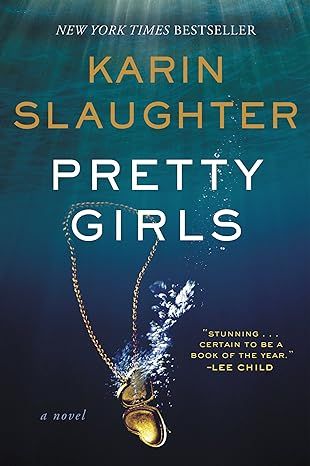
Pretty Girls: A Novel
4.3
-
88,539
$3.67

The Bad Weather Friend
4.1
-
34,750
$12.78

Pucking Around: A Why Choose Hockey Romance (Jacksonville Rays Hockey)
4.3
-
41,599
$14.84
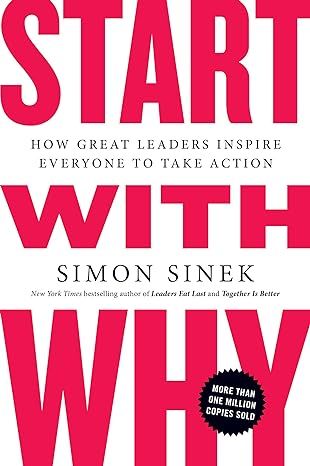
Start with Why: How Great Leaders Inspire Everyone to Take Action
4.6
-
37,152
$9.99
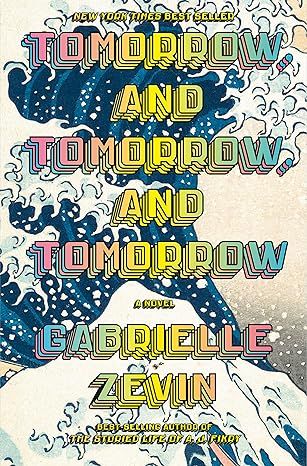
Tomorrow, and Tomorrow, and Tomorrow: A novel
4.4
-
95,875
$13.99

Weyward: A Novel
4.4
-
27,652
$11.99

Tom Lake: A Reese's Book Club Pick
4.3
-
37,302
$15.74

All the Sinners Bleed: A Novel
4.4
-
12,894
$13.55
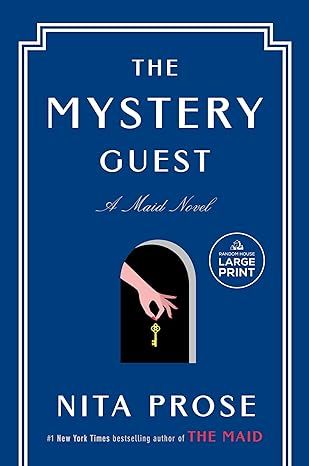
The Mystery Guest: A Maid Novel (Molly the Maid)
4.3
-
9,844
$14.99

Bright Young Women: A Novel
4.2
-
8,485
$14.99

The Wager: A Tale of Shipwreck, Mutiny and Murder (Random House Large Print)
4.5
-
28,672
$14.99
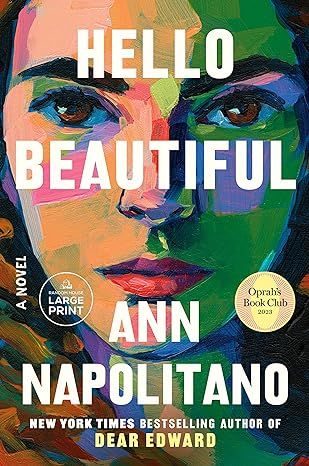
Hello Beautiful (Oprah's Book Club): A Novel (Random House Large Print)
4.4
-
79,390
$14.99

Small Mercies: A Detective Mystery
4.5
-
16,923
$10.00

Holly
4.5
-
31,521
$14.99

The Covenant of Water (Oprah's Book Club)
4.6
-
69,712
$9.24

Wellness: A novel
4.1
-
3,708
$14.99
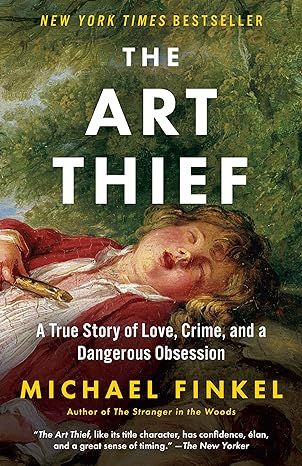
The Art Thief: A True Story of Love, Crime, and a Dangerous Obsession
4.3
-
4,805
$14.99

The Berry Pickers: A Novel
4.5
-
14,209
$14.99

Elon Musk
4.7
-
15,272
$16.99

Just for the Summer
4.6
-
19,524
$11.99
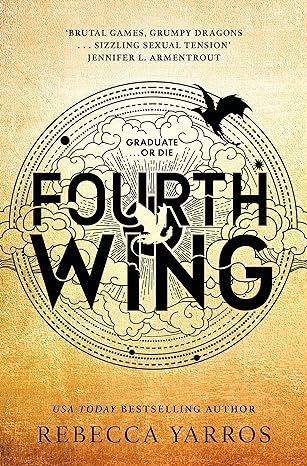
Fourth Wing (International Edition)
4.8
-
206,495
$7.95
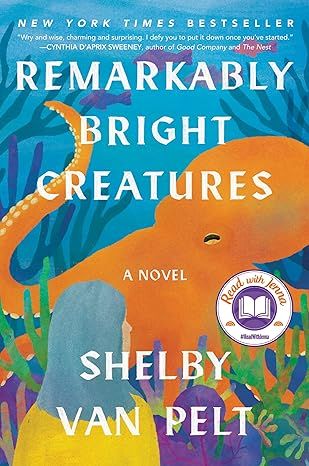
Remarkably Bright Creatures: A Read with Jenna Pick
4.6
-
65,556
$15.80
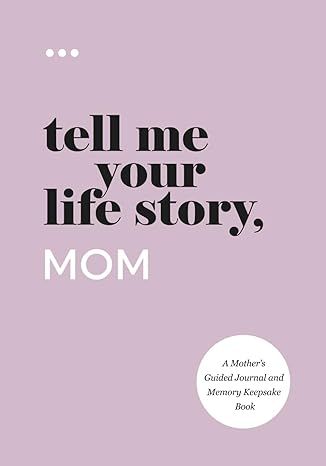
Tell Me Your Life Story, Mom: A Mother’s Guided Journal and Memory Keepsake Book (Tell Me Your Life Story® Series Books)
4.7
-
5,107
$11.24
